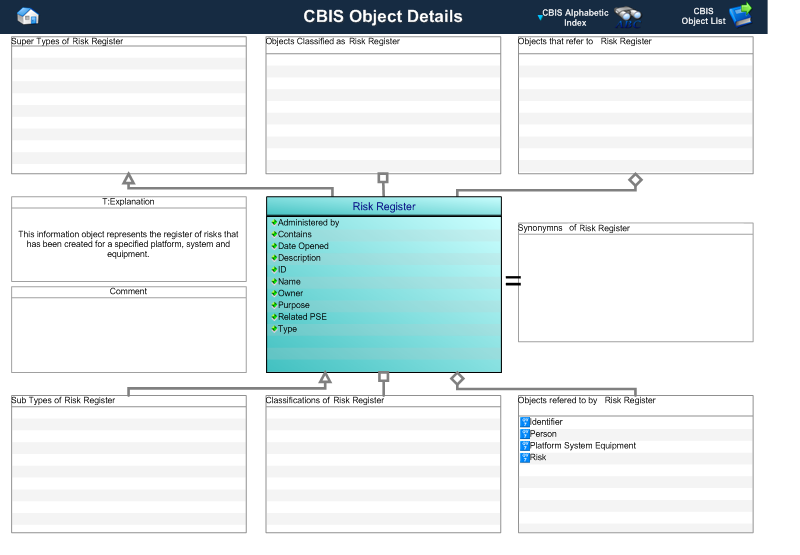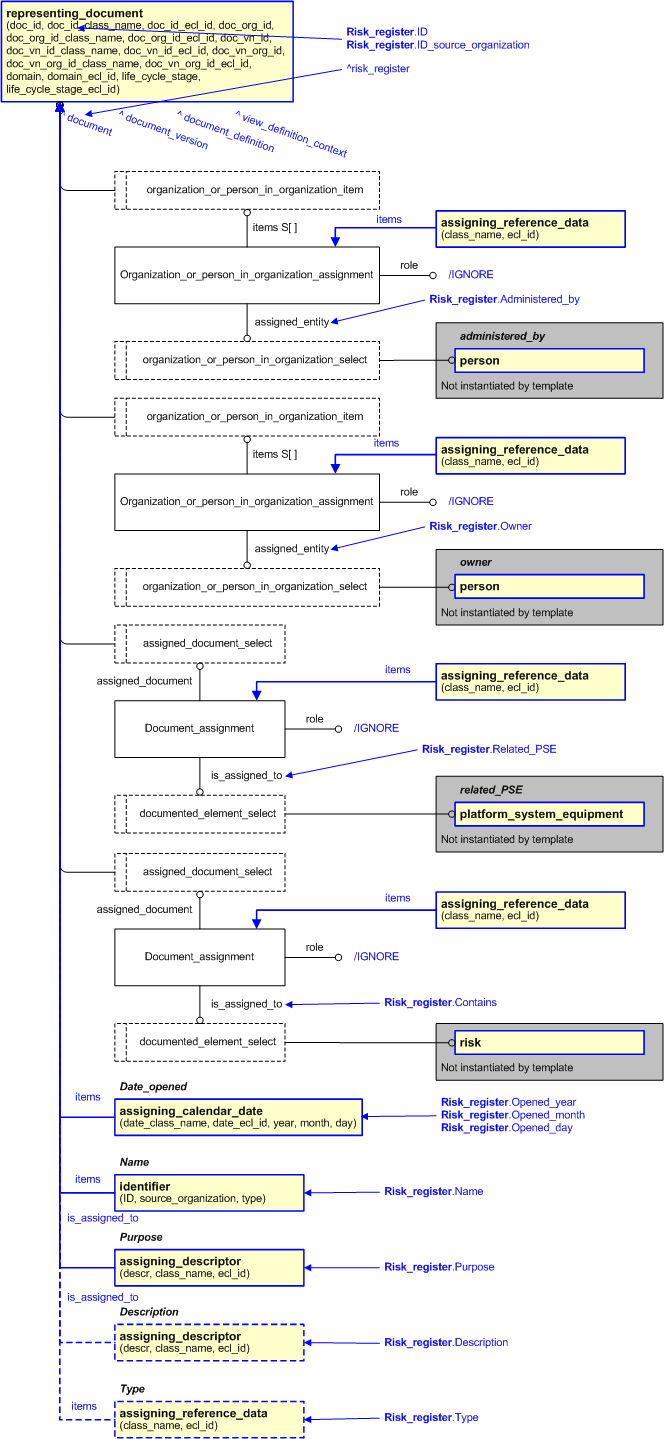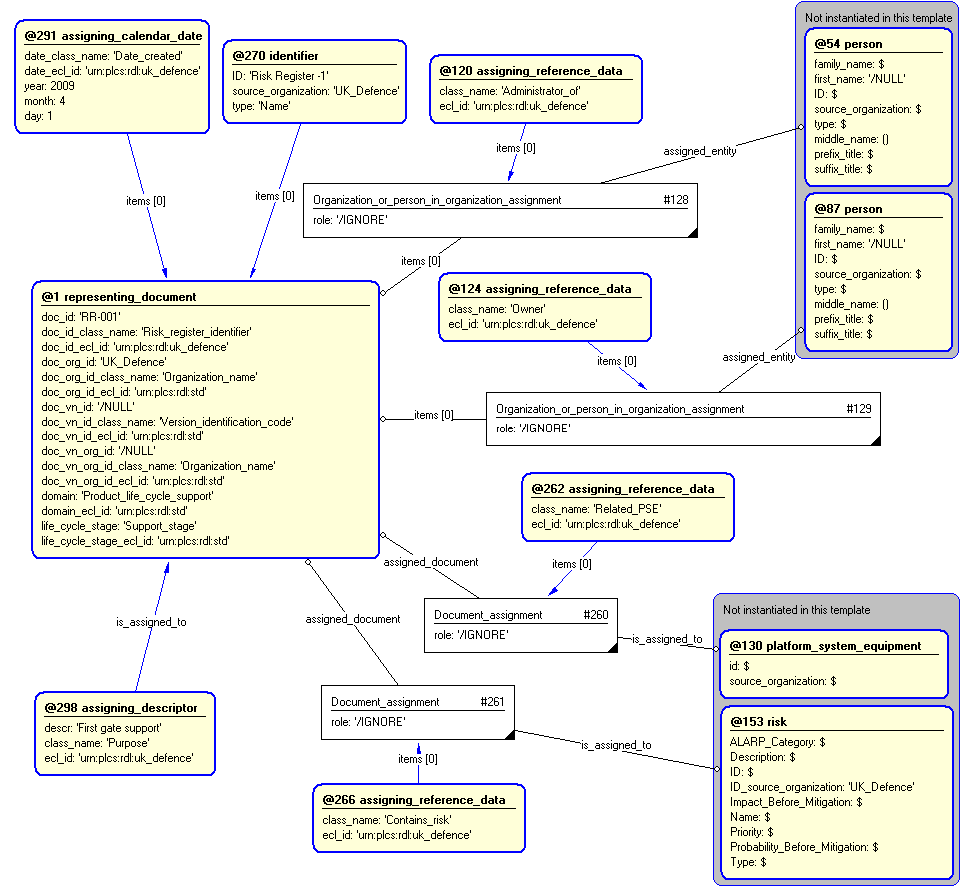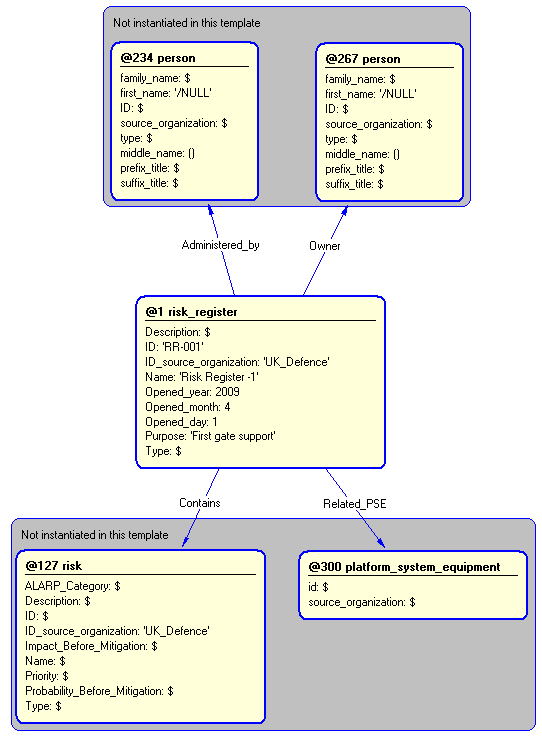Template:— risk_register (rsk_reg)
Context:— UK_Defence |
Date: 2010/03/15 15:08:44
Revision: 1.4
|
This section specifies the template risk_register.
NOTE
The template has been defined in the context of
UK_Defence.
Refer to the business context for details of related templates.
NOTE
An explanation of a template and the associated instantiation path is
provided in the
Template overview
section.
This template describes how to represent the concept of risk register in terms of PLCS model elements (templates, entities
and reference data).
A risk register identifies the risks tracked for a specified platform, system and equipment
This information object represents the register of risks that has been created for a specified platform, system and equipment.
Figure 1 — A MOOD Business Architect representation of the Business Object: Risk register
The attributes of the risk register object are tabled below.
|
Attribute name
|
Attribute description
|
Attribute type
|
Optionality
|
| Administered by |
This is the reference to the person that administers the risk register. |
Person |
Mandatory |
| Contains |
This is the reference to the set of risks that are contained within the register. |
Risk |
Mandatory [1:?] |
| Date Opened |
This is the date on which the risk register was opened. |
intrinsic |
Mandatory |
| Description |
This is the description of the risk register. |
intrinsic |
Optional |
| ID |
This is the identifier of the risk register. |
intrinsic |
Mandatory |
| Name |
This is the name of the risk register. |
intrinsic |
Mandatory |
| Owner |
This is the reference to the person that owns the risk register. |
Person |
Mandatory |
| Purpose |
This is the purpose of the risk register. |
intrinsic |
Mandatory |
| Related PSE |
This is the reference to the PSE for which the register has been defined. |
Platform System Equipment |
Mandatory |
| Type |
This is the type of the risk register. |
intrinsic |
Optional |
Table 1 — Risk register attribute details
NOTE
This template is dependent on entities in the ISO10303-239 Edition 2 schema.
The EXPRESS-G diagram in
Figure
2
shows the templates and EXPRESS entities that are required
to represent the template
"risk_register".
The text highlighted in blue shows the template parameters.
Figure 2 — An EXPRESS-G representation of the Information model for risk_register
The graphic for the template to be used in other EXPRESS-G diagrams
is shown in Figure
3
below.
Figure 3 — The graphical representation of the risk_register template
The following input parameters are defined for this template:
This is the reference to the person that administers the risk register.
Contains (Type=
'ENTITY
(
![[warning:]]() Error ER1: The entity Risk_perception does not exist
Error ER1: The entity Risk_perception does not existRisk_perception)'
![[warning:]]() Error EXP-1: The EXPRESS entity Risk_perception
Error EXP-1: The EXPRESS entity Risk_perception
does not exist in data/schemas/ap239_arm_lf.xml.)
This is the reference to the set of risks that are contained within the register.
This is the description of the risk register.
This is the identifier of the risk register.
The organization that created the associated identifier. Additionally
a Person or Information System could be defined when either of these are the source; see Identifier template characterizations
This is the name of the risk register.
This is the year in which the risk register was opened.
This is the month in which the risk register was opened.
This is the day on which the risk register was opened.
This is the reference to the person that owns the risk register.
This is the purpose of the risk register.
This is the reference to the PSE for which the register has been defined.
Type (Type='CLASS', Optional)
This is the type of the risk register.
The following classes and their sub-classes can be used:
classifications: [Risk_register_type]![[warning:]](../../../../../../images/dex/warning.gif) Error RDL4: The URI urn:plcs:rdl:uk_defence is not listed in dexlib/data/refdata/rdl_index.xml
Error RDL4: The URI urn:plcs:rdl:uk_defence is not listed in dexlib/data/refdata/rdl_index.xml
The following reference parameters are defined for this template:
Allow the
Document
entity instantiated in this path to be referenced when this template is used.
Note: The
Document
entity can be referenced in a template path by:
%^target = $risk_register.rsk_reg%
where
target
is the parameter to which the
Document
is bound.
The following parameter combinations specify a uniqueness constraint:
Unique constraint: Risk register
Each instance of the
entity
(
Document)
within the data set shall be uniquely identified
by a combination of the following parameters on this
template (risk_register) namely:
ID,
Purpose,
Related_PSE.
The
instance is
referenced by the following template parameter:
rsk_reg.
The instantiation path shown below specifies the entities that are to be
instantiated by the template.
A description of templates and the syntax for the instantiation path is
provided in the
Templates Help/Information section.
-- Representing document /
representing_document(
doc_id=@ID,
doc_id_class_name='Risk_register_identifier',
doc_id_ecl_id='urn:plcs:rdl:uk_defence',
doc_org_id=@ID_source_organization,
doc_org_id_class_name='Organization_name',
doc_org_id_ecl_id='urn:plcs:rdl:std',
doc_vn_id=/NULL,
doc_vn_id_class_name='Version_identification_code',
doc_vn_id_ecl_id='urn:plcs:rdl:std',
doc_vn_org_id='/NULL',
doc_vn_org_id_class_name='Organization_name',
doc_vn_org_id_ecl_id='urn:plcs:rdl:std',
domain='Product_life_cycle_support',
domain_ecl_id='urn:plcs:rdl:std',
life_cycle_stage='Support_stage',
life_cycle_stage_ecl_id='urn:plcs:rdl:std')/
%^risk_register = $representing_document.document%
-- Create relationship to administered_by Organization_or_person_in_organization_assignmentOrganization_or_person_in_organization_assignment.items ->
^risk_register
Organization_or_person_in_organization_assignment.assigned_entity ->
@Administered_byOrganization_or_person_in_organization_assignment.role = '/IGNORE'
%^adm_by =
Organization_or_person_in_organization_assignment%
/
assigning_reference_data(
class_name='Administrator_of',
ecl_id='urn:plcs:rdl:uk_defence',
items=^adm_by)/
-- Create relationship to owner Organization_or_person_in_organization_assignmentOrganization_or_person_in_organization_assignment.items ->
^risk_register
Organization_or_person_in_organization_assignment.assigned_entity ->
@OwnerOrganization_or_person_in_organization_assignment.role = '/IGNORE'
%^ownr =
Organization_or_person_in_organization_assignment%
/
assigning_reference_data(
class_name='Owner_of',
ecl_id='urn:plcs:rdl:uk_defence',
items=^ownr)/
-- Create relationship to Contains Document_assignmentDocument_assignment.role = '/IGNORE'
Document_assignment.assigned_document ->
^risk_register
Document_assignment.is_assigned_to ->
@Contains%^cont =
Document_assignment%
/
assigning_reference_data(
class_name='Contains_risk',
ecl_id='urn:plcs:rdl:uk_defence',
items=^cont)/
-- Create relationship to Related_PSE Document_assignmentDocument_assignment.role = '/IGNORE'
Document_assignment.assigned_document ->
^risk_register
Document_assignment.is_assigned_to ->
@Related_PSE%^rpse =
Document_assignment%
/
assigning_reference_data(
class_name='Related_PSE',
ecl_id='urn:plcs:rdl:uk_defence',
items=^rpse)/
-- Date_opened /
assigning_calendar_date(
date_class_name='Date_created',
date_ecl_id='urn:plcs:rdl:uk_defence',
year=@Opened_year,
month=@Opened_month,
day=@Opened_day,
items=^risk_register)/
-- Name /
identifier(
ID=@Name,
source_organization=@ID_source_organization,
type='Name',
items=^risk_register)/
-- Purpose /
assigning_descriptor(
descr=@Purpose,
class_name='Purpose',
ecl_id='urn:plcs:rdl:uk_defence',
is_assigned_to=^risk_register)/
-- [optional Description] /
assigning_descriptor(
descr=@Description,
class_name='Description',
ecl_id='urn:plcs:rdl:uk_defence',
is_assigned_to=^risk_register)/
-- [optional Type] /
assigning_reference_data(
class_name=@Type,
ecl_id='urn:plcs:rdl:uk_defence',
items=^risk_register)/
The following entities are instantiated with attributes as specified:
The instance diagram in Figure
4
shows an example of the EXPRESS entities and templates that are instantiated by the template:
/risk_register(Administered_by='#a', Contains='#c', ID='RR-001', ID_source_organization='UK_Defence', Name='Risk Register -1', Opened_year='2009', Opened_month='4', Opened_day='1', Owner='#o', Purpose='First gate support', Related_PSE='#p')/
(an illustration of the consolidated risk_register template is shown in
Figure
5 below.)
Figure 4 — Entities instantiated by risk_register template
The instance diagram in
Figure
5
shows the graphic symbol for the template that is to be
used in other instance diagrams. The example template is:
/risk_register(Administered_by='#a', Contains='#c', ID='RR-001', ID_source_organization='UK_Defence', Name='Risk Register -1', Opened_year='2009', Opened_month='4', Opened_day='1', Owner='#o', Purpose='First gate support', Related_PSE='#p')/
Figure 5 — Instantiation of risk_register template
Characterizations
No common characterizations of the template
risk_register
have been identified. However, the ISO 10303-239 EXPRESS model
may enable other assignments to the entities instantiated by the template.




